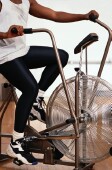
THURSDAY, Feb. 12, 2015 (HealthDay News) — Exercising on a motorized stationary bike may help boost stroke patients’ brain and motor skills recovery, a small study suggests.
The study included 17 stroke survivors, aged 23 to 84, whose stroke occurred six to 12 months before the start of the study. To help them regain the use of their arms, all of the patients took part in repetitive task therapy, such as relearning how to hold a cup or fork, or how to dress themselves.
In addition to this, the patients were randomly assigned to one of three groups: exercise on a motorized stationary bike; using a stationary bike without a motor; or no aerobic exercise at all but twice as much upper body repetitive task therapy. All the cycling sessions lasted 45 minutes and were done before the repetitive task therapy for their arms.
All three groups did 24 exercise sessions over eight weeks. At the end of that time, the patients in the motorized stationary bike group showed a 34 percent improvement in motor skills, compared with a 16 percent improvement in the non-motorized stationary bike group and 17 percent in the group that did extra repetitive tasks but no aerobic exercise, the study found.
All three groups, however, showed improvements in self-reported quality of life and depressive symptoms, but the greatest gains were seen in the motorized stationary bike group, according to the study.
The researchers are scheduled to present their findings Thursday at the American Stroke Association’s annual meeting in Nashville. Findings presented at meetings are considered preliminary until they’ve been published in a peer-reviewed journal.
Previous research has shown that aerobic exercise helps the brain learn new information, and that forced exercise on a motorized stationary bike benefits Parkinson’s disease patients.
Aerobic exercise may help enhance the brain’s ability to reorganize itself and form new connections, the study authors said.
Using a motorized stationary bike helps patients with limited mobility to pedal and achieve and maintain the intensity of training believed necessary to affect brain function, the researchers noted.
“Not only are we improving motor recovery with half the amount of task practice but we’re also improving cardiovascular health, and stroke patients often have cardiovascular (problems),” study author Susan Linder, a physical therapist at the Cleveland Clinic, said in a stroke association news release.
“If we can improve motor recovery and cardiovascular health simultaneously, patients can regain lost motor function and improve their quality of life,” she added.
More information
The U.S. National Library of Medicine has more on stroke rehabilitation.
Copyright © 2025 HealthDay. All rights reserved.

